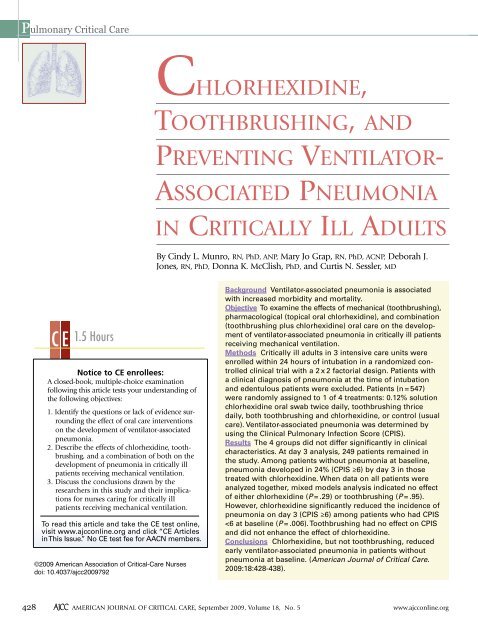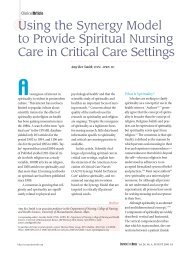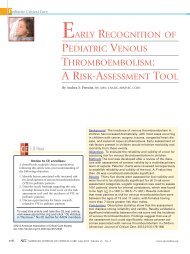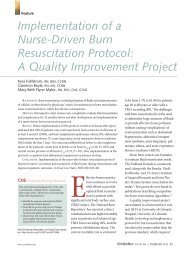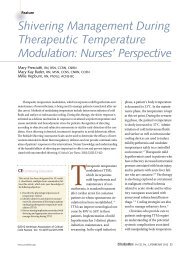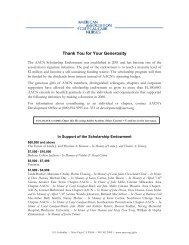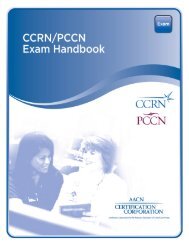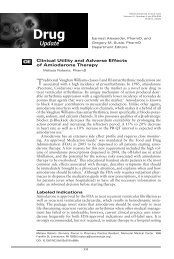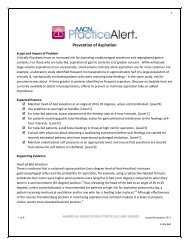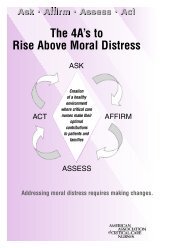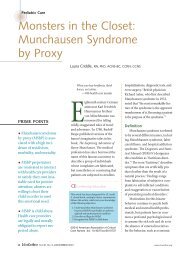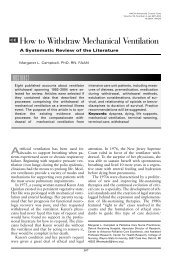Chlorhexidine, Toothbrushing, and Preventing Ventilator Associated ...
Chlorhexidine, Toothbrushing, and Preventing Ventilator Associated ...
Chlorhexidine, Toothbrushing, and Preventing Ventilator Associated ...
You also want an ePaper? Increase the reach of your titles
YUMPU automatically turns print PDFs into web optimized ePapers that Google loves.
Pulmonary Critical Care<br />
C E<br />
1.5 Hours<br />
Notice to CE enrollees:<br />
A closed-book, multiple-choice examination<br />
following this article tests your under st<strong>and</strong>ing of<br />
the following objectives:<br />
1. Identify the questions or lack of evidence surrounding<br />
the effect of oral care interventions<br />
on the development of ventilator-associated<br />
pneumonia.<br />
2. Describe the effects of chlorhexidine, toothbrushing,<br />
<strong>and</strong> a combination of both on the<br />
development of pneumonia in critically ill<br />
patients receiving mechanical ventilation.<br />
3. Discuss the conclusions drawn by the<br />
researchers in this study <strong>and</strong> their implications<br />
for nurses caring for critically ill<br />
patients receiving mechanical ventilation.<br />
To read this article <strong>and</strong> take the CE test online,<br />
visit www.ajcconline.org <strong>and</strong> click “CE Articles<br />
in This Issue.” No CE test fee for AACN members.<br />
©2009 American Association of Critical-Care Nurses<br />
doi: 10.4037/ajcc2009792<br />
CHLORHEXIDINE,<br />
TOOTH BRUSHING, AND<br />
PREVENTING VENTILATOR-<br />
ASSOCIATED PNEUMONIA<br />
IN CRITICALLY ILL ADULTS<br />
By Cindy L. Munro, RN, PhD, ANP, Mary Jo Grap, RN, PhD, ACNP, Deborah J.<br />
Jones, RN, PhD, Donna K. McClish, PhD, <strong>and</strong> Curtis N. Sessler, MD<br />
Background <strong>Ventilator</strong>-associated pneumonia is associated<br />
with increased morbidity <strong>and</strong> mortality.<br />
Objective To examine the effects of mechanical (toothbrushing),<br />
pharmacological (topical oral chlorhexidine), <strong>and</strong> combination<br />
(toothbrushing plus chlorhexidine) oral care on the development<br />
of ventilator-associated pneumonia in critically ill patients<br />
receiving mechanical ventilation.<br />
Methods Critically ill adults in 3 intensive care units were<br />
enrolled within 24 hours of intubation in a r<strong>and</strong>omized controlled<br />
clinical trial with a 2 x 2 factorial design. Patients with<br />
a clinical diagnosis of pneumonia at the time of intubation<br />
<strong>and</strong> edentulous patients were excluded. Patients (n = 547)<br />
were r<strong>and</strong>omly assigned to 1 of 4 treatments: 0.12% solution<br />
chlorhexidine oral swab twice daily, toothbrushing thrice<br />
daily, both toothbrushing <strong>and</strong> chlorhexidine, or control (usual<br />
care). <strong>Ventilator</strong>-associated pneumonia was determined by<br />
using the Clinical Pulmonary Infection Score (CPIS).<br />
Results The 4 groups did not differ significantly in clinical<br />
characteristics. At day 3 analysis, 249 patients remained in<br />
the study. Among patients without pneumonia at baseline,<br />
pneumonia developed in 24% (CPIS ≥6) by day 3 in those<br />
treated with chlorhexidine. When data on all patients were<br />
analyzed together, mixed models analysis indicated no effect<br />
of either chlorhexidine (P = .29) or toothbrushing (P = .95).<br />
However, chlorhexidine significantly reduced the incidence of<br />
pneumonia on day 3 (CPIS ≥6) among patients who had CPIS<br />
<strong>Ventilator</strong>-associated pneumonia (VAP) is defined as pneumonia in patients receiving<br />
mechanical ventilation that was neither present nor developing at the time<br />
of intubation. VAP increases mortality, 1 hospital length of stay, 2,3 <strong>and</strong> health care<br />
costs. 2,4,5 Oral health can be compromised by critical illness <strong>and</strong> by mechanical<br />
ventilation <strong>and</strong> is influenced by nursing care. 6,7 The effect of oral care interventions<br />
on the development of VAP has been of interest to clinicians; however, data from well-controlled<br />
experimental research with adequate sample sizes have not been published.<br />
Many risk factors for VAP have been identified. 8<br />
Major ones include inadequate h<strong>and</strong> washing by<br />
staff, ventilatory circuit management practices, supine<br />
positioning of patients without backrest elevation,<br />
previous antibiotic therapy, presence of a nasogastric<br />
tube, <strong>and</strong> gastric alkalinization. 9,10 Interventions<br />
included in the Institute for Healthcare Improvement’s<br />
ventilator bundle 11 to reduce risk of complications<br />
in patients treated with mechanical ventilation<br />
include elevating the head of the bed to 30º or more,<br />
prophylaxis for peptic ulcer disease <strong>and</strong> deep vein<br />
thrombosis, daily interruption of sedation (sedation<br />
vacation), <strong>and</strong> assessment of readiness to extubate.<br />
Another risk factor for VAP is colonization of<br />
the oropharynx by potential pathogens such as<br />
Staphylococcus aureus, Streptococcus pneumoniae, or<br />
gram-negative rods. 12-15 Several factors contribute to<br />
the association between oral health <strong>and</strong> development<br />
of VAP. Within 48 hours of admission to the intensive<br />
care unit (ICU), oral flora of critically ill patients<br />
undergoes a change to predominantly gram-negative<br />
flora that includes more virulent organisms. 16,17 Dental<br />
plaque can provide a habitat for microorganisms<br />
responsible for VAP, <strong>and</strong> dental plaque of patients<br />
in the ICU can be colonized by potential respiratory<br />
pathogens such as methicillin-resistant S aureus <strong>and</strong><br />
Pseudomonas aeruginosa. 18<br />
Because contamination of the oral cavity by pathogenic<br />
bacteria is associated with VAP, interventions<br />
About the Authors<br />
Cindy L. Munro <strong>and</strong> Mary Jo Grap are professors in the<br />
Adult Health Department, School of Nursing; Donna K.<br />
McClish is an associate professor, Department of Biostatistics;<br />
<strong>and</strong> Curtis N. Sessler is a professor in the Division<br />
of Pulmonary <strong>and</strong> Critical Care Medicine,<br />
Department of Internal Medicine, School of Medicine, at<br />
Virginia Commonwealth University, Richmond, Virginia.<br />
Deborah J. Jones is an assistant professor, Acute <strong>and</strong><br />
Continuing Care Department, University of Texas School<br />
of Nursing at Houston.<br />
Corresponding author: Cindy L. Munro, RN, PhD, ANP, Professor,<br />
School of Nursing, Virginia Commonwealth University,<br />
Box 980567, Richmond, VA 23298-0567 (e-mail:<br />
cmunro@vcu.edu).<br />
to reduce bacteria in the oral cavity have been investigated.<br />
Several studies 19-21 have indicated that application<br />
of topical oral chlorhexidine, initiated before<br />
intubation, reduces nosocomial infections in patients<br />
having elective cardiac surgery. Importantly, however,<br />
cardiac surgery patients are generally extubated<br />
within 48 hours <strong>and</strong> thus have a<br />
low risk for VAP. However, in a<br />
recent meta-analysis, Pineda et al 22<br />
found that chlorhexidine did not<br />
reduce nosocomial pneumonia or<br />
mortality rate. A recommendation<br />
for use of chlorhexidine in patients<br />
other than those having elective cardiac<br />
surgery is not included in<br />
national ventilator bundles or in<br />
recommendations from the Centers<br />
for Disease Control <strong>and</strong> Prevention because no evidence<br />
of the effectiveness of chlorhexidine in general<br />
critical care patients is available. Controlled<br />
studies of the effects of toothbrushing on VAP have<br />
not been reported.<br />
Oral care in critically ill adults is now emerging<br />
as an important issue but has not been well studied<br />
in patients other than those having elective cardiac<br />
surgery. We conducted a r<strong>and</strong>omized, controlled<br />
clinical trial to test the effects of toothbrushing<br />
<strong>and</strong>/or chlorhexidine in reducing the risk for VAP in<br />
adult ICU patients receiving mechanical ventilation.<br />
We hypothesized that oral interventions would reduce<br />
the incidence of VAP.<br />
Methods<br />
Design <strong>and</strong> Sample<br />
A r<strong>and</strong>omized controlled 2 × 2 factorial experimental<br />
design was used, <strong>and</strong> staff who performed<br />
interventions had no knowledge of patients’ Clinical<br />
Pulmonary Infection Score (CPIS). The study was<br />
approved by the Office of Research Subjects Protection<br />
of Virginia Commonwealth University, Richmond,<br />
Virginia, <strong>and</strong> prospective informed consent<br />
for participation was obtained from each patient’s<br />
Dental plaque can<br />
provide a habitat<br />
for microorganisms<br />
responsible for<br />
ventilator-associated<br />
pneumonia.<br />
www.ajcconline.org AJCC AMERICAN JOURNAL OF CRITICAL CARE, September 2009, Volume 18, No. 5 429
Unable to obtain<br />
consent (n = 869)<br />
Met study criteria<br />
(n = 1416)<br />
Figure Study flow.<br />
Screened<br />
(N = 10 910)<br />
Consent obtained<br />
(n = 547)<br />
Patient enrolled <strong>and</strong> r<strong>and</strong>omized to group assignment (n = 547)<br />
Patients<br />
remaining<br />
intubated<br />
Day 1<br />
(n = 471)<br />
Day 2<br />
(n = 330)<br />
Day 3<br />
(n = 249)<br />
Day 5<br />
(n = 158)<br />
Day 7<br />
(n = 109)<br />
<strong>Chlorhexidine</strong><br />
119<br />
79<br />
57<br />
34<br />
23<br />
Intervention <strong>and</strong> data collection<br />
<strong>Toothbrushing</strong><br />
113<br />
79<br />
63<br />
38<br />
26<br />
Did not meet criteria<br />
(n = 9494)<br />
Not intubated (n = 6119)<br />
Intubated >24 hours (n = 963)<br />
Other (n = 2412)<br />
Both chlorhexidine<br />
<strong>and</strong> toothbrushing<br />
116<br />
legally authorized representative. Calculations of<br />
sample sizes were based on the use of a 2 × 2 factorial<br />
experiment. This design permitted the testing of<br />
hypotheses about the effect of each of the individual<br />
interventions (chlorhexidine alone <strong>and</strong> toothbrushing<br />
alone) <strong>and</strong> also provided information about any<br />
interaction between chlorhexidine <strong>and</strong> toothbrushing.<br />
The sample size required to detect an interaction (ie,<br />
the effect of chlorhexidine <strong>and</strong> toothbrushing in combination)<br />
was larger than that required to detect main<br />
effects (ie, chlorhexidine alone or toothbrushing<br />
alone) for a test at a given level of significance. The<br />
study was designed to detect an interactive effect<br />
resulting in a 0.755 difference in mean CPIS score<br />
at a power of 80% <strong>and</strong> a significance level of .05. An<br />
interim analysis was done <strong>and</strong> a Bonferroni adjustment<br />
was used to avoid inflation in the overall significance<br />
level related to interim analyses; for this reason,<br />
the level of significance for final analysis was .025.<br />
84<br />
65<br />
38<br />
26<br />
Usual<br />
care<br />
123<br />
88<br />
64<br />
48<br />
34<br />
Patients were recruited from 3 ICUs at Virginia<br />
Commonwealth University Medical Center, a large<br />
urban hospital. All patients older than 18 years<br />
(n = 10 913) in medical, surgical/trauma, <strong>and</strong> neuroscience<br />
ICUs were screened for inclusion. The Figure<br />
provides information about screening, enrollment,<br />
<strong>and</strong> attrition. Patients were r<strong>and</strong>omized to treatment<br />
within each ICU according to a permuted block<br />
design developed by the biostatistician (D.K.M.)<br />
before the start of the study. Patients receiving<br />
mechanical ventilation were enrolled within 24<br />
hours of intubation. Because reintubation increases<br />
the risk for VAP, 23,24 patients who had had a previous<br />
endotracheal intubation during the current hospital<br />
admission were excluded. Edentulous patients were<br />
excluded because dental plaque could not be<br />
assessed. Patients with a clinical diagnosis of pneumonia<br />
at the time of intubation were excluded<br />
because determination of nosocomial pneumonia is<br />
confounded in patients with preexisting pneumonia.<br />
Consent was obtained for 547 patients.<br />
Patients remained in the study for a maximum<br />
of 7 days unless extubated; for patients extubated<br />
before day 7, participation in the study ended on<br />
the day of extubation. This step was necessary because<br />
VAP was scored by using the CPIS, <strong>and</strong> variables<br />
necessary for computation of the CPIS (eg, number<br />
of times endotracheal suctioning was performed,<br />
ventilator settings, endotracheal tube cultures) were<br />
not available after extubation. The primary outcome<br />
of the study was the CPIS on day 3. On day 3, the<br />
analysis sample consisted of 192 patients, 116<br />
patients remained in the analysis sample on day 5,<br />
<strong>and</strong> 76 patients were analyzed on day 7.<br />
Oral Care<br />
Patients were r<strong>and</strong>omly assigned to 1 of 4<br />
treatments: a 0.12% solution of chlorhexidine gluconate<br />
(chlorhexidine) 5 mL by oral swab twice<br />
daily (at 10 AM <strong>and</strong> 10 PM), toothbrushing 3 times<br />
a day (at 9 AM, 2 PM, <strong>and</strong> 8 PM), combination care<br />
(toothbrushing 3 times a day <strong>and</strong> chlorhexidine<br />
every 12 hours), or control (usual care). A 0.12%<br />
solution of chlorhexidine gluconate was used because<br />
this is the formulation approved by the Food <strong>and</strong><br />
Drug Administration in the United States. <strong>Chlorhexidine</strong><br />
<strong>and</strong> toothbrushing were provided by study<br />
personnel. Study personnel who provided oral care<br />
had no knowledge of patients’ CPIS results.<br />
The toothbrushing protocol was developed in<br />
consultation with dental hygienist faculty <strong>and</strong> was<br />
based on recommendations of the American Dental<br />
Association for healthy populations. Each patient’s<br />
mouth was divided into 4 dental quadrants (right<br />
430 AJCCAMERICAN JOURNAL OF CRITICAL CARE, September 2009, Volume 18, No. 5 www.ajcconline.org
upper, right lower, left upper, left lower), <strong>and</strong> each<br />
quadrant was brushed in a defined pattern. In each<br />
quadrant, every tooth was brushed for 5 strokes on<br />
lingual, buccal, <strong>and</strong> biting surfaces with a soft pediatric<br />
toothbrush <strong>and</strong> toothpaste (Biotene toothpaste,<br />
Laclede, Inc, Rancho Dominguez, California). The<br />
palate <strong>and</strong> tongue were also brushed. Each quadrant,<br />
the palate, <strong>and</strong> the tongue were rinsed with mouthwash<br />
(Biotene), 2.5 mL per area, by using a transfer<br />
pipette. A Yankauer suction catheter was used as<br />
needed to suction excess saliva <strong>and</strong> water from the<br />
mouth as the intervention was performed. Finally, a<br />
measured amount of moisturizing gel (OralBalance,<br />
Laclede, Inc) was applied to all soft surfaces of the<br />
oral cavity <strong>and</strong> lips by using a green Toothette swab<br />
(Sage Products, Inc, Cary, Illinois).<br />
<strong>Chlorhexidine</strong> was applied in a defined pattern<br />
by using a green Toothette swab to evenly coat each<br />
tooth, the tongue, <strong>and</strong> the palate. A commercially<br />
available chlorhexidine solution was dispensed by<br />
the investigational drug pharmacy for use in the study.<br />
Measurement <strong>and</strong> Quantification of Key Variables<br />
<strong>Ventilator</strong>-<strong>Associated</strong> Pneumonia. Development of<br />
VAP was quantified by using the CPIS. 25 Microbial<br />
cultures of tracheal aspirates were performed by the<br />
hospital’s clinical support laboratory (which has<br />
Clinical Laboratory Improvement Amendments<br />
certification) by laboratory personnel who had no<br />
knowledge of any patient’s treatment assignment.<br />
Chest radiographs were interpreted by an intensivist<br />
board certified in critical care medicine (C.S.) who<br />
had no knowledge of any patient’s treatment assignment.<br />
Data for CPIS calculation were collected on<br />
study days 1, 3, 5, <strong>and</strong> 7.<br />
For the CPIS, points are assigned to 6 easily<br />
obtained variables: temperature, white blood cell<br />
count, tracheal secretions, oxygenation (calculated<br />
as PaO 2 divided by the fraction of inspired oxygen),<br />
findings on chest radiographs (no infiltrate, diffuse<br />
infiltrate, localized infiltrate), <strong>and</strong> results of culturing<br />
of tracheal aspirates (microscopic examination<br />
<strong>and</strong> semiquantitative culture of tracheal secretions,<br />
scored by using the same scale as that used for the<br />
oral cultures). Points for each variable of the CPIS<br />
are summed, yielding a total CPIS, which provides<br />
a range of scores from 0 to 12 for data analysis.<br />
Although the CPIS has been used by some investigators<br />
26,27 as a dichotomous measure of VAP (defining<br />
CPIS ≥6 as a diagnosis of pneumonia <strong>and</strong> CPIS
Table 1<br />
Characteristics of enrolled sample <strong>and</strong> of day 3 analysis sample<br />
Variable a<br />
Sex<br />
Male<br />
Female<br />
Race<br />
White<br />
Nonwhite<br />
Intensive care unit<br />
Medical respiratory<br />
Neurosurgical<br />
Surgical trauma<br />
Intubation process<br />
Elective<br />
Urgent<br />
Emergent<br />
Antibiotics at admissionb Yes<br />
No<br />
Age, mean (SD), y<br />
No. of decayed, missing, <strong>and</strong> filled<br />
teeth, mean (SD)<br />
Severity of illness (Acute Physiology<br />
<strong>and</strong> Chronic Health Evaluation III)<br />
score, mean (SD)<br />
Length of stay in intensive care unit,<br />
median, days<br />
Length of stay in hospital, median, days<br />
Outcome<br />
Discharged alive<br />
Died during hospitalization<br />
Enrolled sample<br />
(n = 547)<br />
328 (60)<br />
219 (40)<br />
227 (41)<br />
320 (59)<br />
147 (27)<br />
168 (31)<br />
232 (42)<br />
206 (38)<br />
171 (31)<br />
170 (31)<br />
85 (18)<br />
381 (82)<br />
47.9 (17.5)<br />
9.3 (8.5)<br />
73.1 (27.3)<br />
6.0<br />
13.0<br />
430 (79)<br />
117 (21)<br />
Toothbrush only<br />
(n = 49)<br />
28 (57)<br />
21 (43)<br />
22 (45)<br />
27 (55)<br />
9 (18)<br />
13 (27)<br />
27 (55)<br />
19 (39)<br />
14 (29)<br />
16 (33)<br />
11 (22)<br />
38 (78)<br />
47.1 (15.7)<br />
10.0 (8.3)<br />
76.4 (23.3)<br />
10.8<br />
23.4<br />
39 (80)<br />
10 (20)<br />
values by treatment group. The interaction of toothbrushing<br />
<strong>and</strong> chlorhexidine was initially included in<br />
each model; because the interaction of toothbrushing<br />
<strong>and</strong> chlorhexidine was not significant, the interaction<br />
was not included in final analysis models.<br />
The final models included terms for the main effects<br />
of toothbrushing <strong>and</strong> chlorhexidine along with the<br />
covariates ICU (a stratification variable) <strong>and</strong> baseline<br />
CPIS score. Logistic regression was used to compare<br />
proportions of patients in each group with<br />
pneumonia (CPIS score ≥6) in a similar manner,<br />
again with controls for ICU <strong>and</strong> baseline CPIS score.<br />
Analysis was performed on data of all patients in<br />
the analysis sample, as well as data of the subset of<br />
patients who had a CPIS less than 6 at baseline.<br />
Day 3 analysis sample (n = 192),<br />
by r<strong>and</strong>omized intervention group<br />
<strong>Chlorhexidine</strong> only<br />
(n = 44)<br />
26 (59)<br />
18 (41)<br />
22 (50)<br />
22 (50)<br />
13 (30)<br />
12 (27)<br />
19 (43)<br />
15 (34)<br />
17 (39)<br />
12 (27)<br />
7 (16)<br />
37 (84)<br />
46.1 (18.2)<br />
8.4 (7.9)<br />
80.4 (28.7)<br />
28 (58)<br />
20 (42)<br />
19 (40)<br />
29 (60)<br />
13 (27)<br />
18 (38)<br />
17 (35)<br />
18 (38)<br />
13 (27)<br />
17 (35)<br />
6 (12)<br />
42 (83)<br />
47.3 (18.8)<br />
8.3 (7.7)<br />
76.2 (25.5)<br />
37 (73)<br />
14 (27)<br />
22 (43)<br />
29 (57)<br />
12 (24)<br />
12 (24)<br />
27 (53)<br />
16 (31)<br />
20 (39)<br />
15 (29)<br />
8 (16)<br />
43 (84)<br />
46.8 (16.4)<br />
10.3 (8.5)<br />
76.2 (3.3)<br />
The study was designed to have an interim<br />
analysis, with Bonferroni correction used to adjust<br />
the P value. A single interim analysis was performed<br />
<strong>and</strong> did not provide sufficient evidence to stop the<br />
study, so the investigation continued to completion.<br />
Thus, a comparison was statistically significant<br />
when P < .025.<br />
Results<br />
Description of the Sample<br />
Characteristics of the sample are summarized<br />
in Table 1. A total of 60% were male, 59% were<br />
nonwhite (56% black, 2% other/unknown), <strong>and</strong> 98%<br />
were non-Hispanic. Mean age was 47.9 years (SD,<br />
17.5); mean APACHE III score was 77 (SD, 25.6).<br />
432 AJCCAMERICAN JOURNAL OF CRITICAL CARE, September 2009, Volume 18, No. 5 www.ajcconline.org<br />
10.7<br />
22.1<br />
31 (70)<br />
13 (30)<br />
Both<br />
(n = 48)<br />
11.7<br />
19.6<br />
36 (75)<br />
12 (25)<br />
Control<br />
(n = 51)<br />
14.2<br />
24.3<br />
42 (82)<br />
9 (18)<br />
a All values are No. (%) unless indicated otherwise. Because of rounding, not all percentages total 100. The intervention groups did not differ significantly<br />
in any variable.<br />
b Only 466 of the 547 patients enrolled in the study had data for this variable.
Table 2<br />
Comparison of baseline <strong>and</strong> day 3 outcomes by treatment<br />
Outcomes<br />
Clinical Pulmonary<br />
Infection Score, mean (SD)<br />
<strong>Chlorhexidine</strong><br />
Yes<br />
No<br />
<strong>Toothbrushing</strong><br />
Yes<br />
No<br />
Pneumonia, %<br />
<strong>Chlorhexidine</strong><br />
Yes<br />
No<br />
<strong>Toothbrushing</strong><br />
Yes<br />
No<br />
5.36 (2.17)<br />
5.70 (2.35)<br />
5.66 (2.38)<br />
5.41 (2.16)<br />
51.1<br />
58.0<br />
55.7<br />
53.7<br />
All patients (n = 192)<br />
Clinical characteristics did not differ significantly<br />
among groups. Of the 547 enrolled patients, 249<br />
were still endotracheally intubated on study day 3;<br />
of these, 209 patients had complete day 3 CPIS<br />
data. Because of missing values on some of the<br />
components of the CPIS, only 192 patients had<br />
CPIS values on both days 1 <strong>and</strong> 3, <strong>and</strong> their data<br />
could be analyzed completely. Comparison of the<br />
192 patients in this analysis sample with the rest of<br />
the patients who were enrolled indicated no significant<br />
differences in baseline variables (sex, intubation<br />
process or reason, ICU, use of antibiotics at<br />
the time of admission, age, <strong>and</strong> count of decayed,<br />
missing, <strong>and</strong> filled teeth) except for the APACHE III<br />
score; those in the analysis sample had higher<br />
APACHE III scores than the other patients did. Patients<br />
in the analysis sample also had longer lengths of stay<br />
than did the other patients but did not have greater<br />
mortality. Comparison of data for patients in the<br />
day 3 analysis sample (n = 192) with data for patients<br />
missing CPIS components on either day 1 or 3 showed<br />
no significant differences in baseline variables.<br />
On day 5, a total of 158 patients remained<br />
intubated (116 patients in analysis sample), <strong>and</strong><br />
109 patients remained intubated through day 7<br />
(76 patients in analysis sample). Because patients<br />
remained in the study only while intubated <strong>and</strong><br />
5.26 (2.44)<br />
5.78 (2.20)<br />
5.58 (2.34)<br />
5.48 (2.33)<br />
41.3<br />
55.0<br />
49.5<br />
47.4<br />
3.56 (1.29)<br />
3.36 (1.16)<br />
3.49 (1.30)<br />
3.43 (1.17)<br />
receiving mechanical ventilation, an important reason<br />
for attrition was extubation; patients’ death related to<br />
critical illness was another source of attrition.<br />
Baseline counts of decayed, missing, <strong>and</strong> filled<br />
teeth (Table 1) indicated that many patients had<br />
oral health problems before admission.<br />
Although patients with a clinical diagnosis of<br />
pneumonia were excluded from the study, we unexpectedly<br />
found that many patients met our research<br />
definition of pneumonia (CPIS ≥6) at the time data<br />
were collected for admission to the study. We were<br />
not able to use CPIS ≥6 as a criterion for exclusion<br />
from the study because doing so would have resulted<br />
in a substantial delay in initiation of study interventions;<br />
the CPIS cannot be calculated until results of<br />
chest radiographs <strong>and</strong> microbial cultures are available,<br />
<strong>and</strong> unblinding study personnel to patients’<br />
baseline CPIS scores would have been necessary.<br />
Thus, at the time of data analysis, we identified 2<br />
subsets of patients on the basis of initial CPIS scores<br />
at the time of admission to the study: patients without<br />
pneumonia at baseline (ie, did not meet the<br />
research definition of pneumonia of CPIS
Table 3<br />
Comparison of baseline <strong>and</strong> day 5 outcomes by treatment<br />
Outcomes<br />
Clinical Pulmonary<br />
Infection Score, mean (SD)<br />
<strong>Chlorhexidine</strong><br />
Yes<br />
No<br />
<strong>Toothbrushing</strong><br />
Yes<br />
No<br />
Pneumonia, %<br />
<strong>Chlorhexidine</strong><br />
Yes<br />
No<br />
<strong>Toothbrushing</strong><br />
Yes<br />
No<br />
5.32 (2.32)<br />
5.65 (2.26)<br />
5.63 (2.37)<br />
5.37 (2.22)<br />
51.8<br />
60.0<br />
57.4<br />
54.8<br />
All patients (n = 116)<br />
5.71 (2.39)<br />
5.72 (2.49)<br />
5.52 (2.22)<br />
5.89 (2.61)<br />
53.6<br />
48.3<br />
55.6<br />
46.8<br />
Effects of Intervention on VAP<br />
Table 2 presents results for the main effects of<br />
toothbrushing <strong>and</strong> of chlorhexidine on the basis of<br />
CPIS values at day 3. The interaction of toothbrushing<br />
<strong>and</strong> chlorhexidine was not significant, so the<br />
interaction was not included in final analysis models.<br />
Thus, the tables present results for main effects<br />
of toothbrushing <strong>and</strong> chlorhexidine by treatment,<br />
rather than by treatment group assignment. When<br />
the entire sample was considered,<br />
neither chlorhexidine nor toothbrushing<br />
had significant effects on<br />
CPIS values or on pneumonia<br />
(CPIS ≥6). The interaction of toothbrushing<br />
<strong>and</strong> chlorhexidine was<br />
not significant. However, in the<br />
subset of patients who did not<br />
already have a CPIS ≥6 on day 1, patients who<br />
received chlorhexidine had significantly lower CPIS<br />
values on day 3, <strong>and</strong> pneumonia (CPIS ≥6) developed<br />
in significantly fewer patients by day 3; toothbrushing<br />
was not associated with lower day 3 CPIS<br />
values or less pneumonia in this subset.<br />
Data for days 5 <strong>and</strong> 7 are presented in Tables 3<br />
<strong>and</strong> 4. Significant relationships between groups<br />
were not apparent, perhaps because of smaller<br />
sample sizes related to attrition. The number of<br />
patients with data for analysis at day 5 decreased<br />
from 192 to 116 (from 87 to 51 without pneumonia)<br />
3.33 (1.36)<br />
3.33 (1.27)<br />
3.43 (1.44)<br />
3.25 (1.20)<br />
<strong>and</strong> further decreased at day 7 (to 76 <strong>and</strong> 37 without<br />
pneumonia).<br />
Discussion<br />
VAP is associated with increased health care<br />
costs, morbidity, <strong>and</strong> mortality. <strong>Chlorhexidine</strong> oral<br />
swabbing was effective in reducing early VAP in<br />
patients in medical, surgical/trauma, <strong>and</strong> neuroscience<br />
ICUs who did not have pneumonia at baseline.<br />
<strong>Toothbrushing</strong> did not reduce the incidence of<br />
VAP, <strong>and</strong> combining toothbrushing <strong>and</strong> chlorhexidine<br />
did not provide additional benefit over use of<br />
chlorhexidine alone.<br />
This project was a r<strong>and</strong>omized, controlled clinical<br />
trial to determine if 2 oral care interventions,<br />
chlorhexidine <strong>and</strong> toothbrushing, would reduce the<br />
risk for VAP during the first week of intubation in<br />
critically ill adults receiving mechanical ventilation.<br />
The sample was diverse in race <strong>and</strong> included both<br />
men <strong>and</strong> women. Severity of illness was appropriate<br />
for a large urban medical center, <strong>and</strong> the VAP rate<br />
observed was similar to published rates. 31<br />
In our previous studies on the effect of oral<br />
health status on development of VAP, we found that<br />
increased dental plaque was predictive of pneumonia<br />
in patients with lower baseline CPIS values. 32 At<br />
that time, we speculated that patients who did not<br />
yet have indications of pulmonary infection might<br />
derive the most benefit from interventions to reduce<br />
434 AJCCAMERICAN JOURNAL OF CRITICAL CARE, September 2009, Volume 18, No. 5 www.ajcconline.org<br />
.48<br />
.37<br />
.24<br />
.27<br />
Patients without pneumonia<br />
at baseline (n = 51)<br />
Day 1 Day 5 P Day 1 Day 5<br />
a P b<br />
— c<br />
—<br />
—<br />
—<br />
5.26 (2.21)<br />
5.25 (2.21)<br />
5.35 (2.21)<br />
5.18 (2.21)<br />
a P comparing those with <strong>and</strong> without the specific intervention, for all patients; analyses controlling for intensive care unit (strata), baseline Clinical Pulmonary<br />
Infection Score, <strong>and</strong> presence of other intervention.<br />
b P comparing those with <strong>and</strong> without the specific intervention, for patients without pneumonia at baseline; analysis controlling for intensive care unit<br />
(strata), baseline Clinical Pulmonary Infection Score, <strong>and</strong> presence of other intervention.<br />
c Dash indicates not applicable.<br />
Many subjects<br />
had oral health<br />
problems before<br />
admission.<br />
44<br />
42<br />
52<br />
36<br />
.94<br />
.84<br />
.84<br />
.23
Table 4<br />
Comparison of baseline <strong>and</strong> day 7 outcomes by treatment<br />
Outcomes<br />
Clinical Pulmonary<br />
Infection Score, mean (SD)<br />
<strong>Chlorhexidine</strong><br />
Yes<br />
No<br />
<strong>Toothbrushing</strong><br />
Yes<br />
No<br />
Pneumonia, %<br />
<strong>Chlorhexidine</strong><br />
Yes<br />
No<br />
<strong>Toothbrushing</strong><br />
Yes<br />
No<br />
5.11 (2.49)<br />
5.70 (2.14)<br />
5.59 (2.46)<br />
5.29 (2.21)<br />
47<br />
55<br />
53<br />
50<br />
All patients (n = 76)<br />
dental plaque. The finding in the current study that<br />
chlorhexidine was beneficial on day 3 in the subset<br />
of patients who had baseline CPIS values
<strong>Toothbrushing</strong> alone<br />
did not reduce<br />
ventilator-associated<br />
pneumonia, <strong>and</strong><br />
combining toothbrushing<br />
with<br />
chlorhexidine did<br />
not provide additional<br />
benefit over<br />
chlorhexidine alone.<br />
Risk of ventilatorassociated<br />
pneumonia begins<br />
with intubation;<br />
so too should<br />
prevention efforts.<br />
the year after the educational program. However,<br />
oral care (“provide oral hygiene at least once daily”)<br />
was only 1 of 14 recommendations, which also<br />
included extubating patients as soon as possible, elevating<br />
the head of the bed, reducing unnecessary use<br />
of antibiotics, <strong>and</strong> ventilatory circuit management).<br />
The direct contribution of tooth-<br />
brushing to VAP reduction was not<br />
ascertainable. In a follow-up study 34<br />
conducted by the same group using<br />
the same design in 4 hospitals (a<br />
pediatric teaching hospital, an adult<br />
teaching hospital, <strong>and</strong> 2 community<br />
hospitals in an integrated health system),<br />
combined VAP rates decreased<br />
significantly (P < .001) even though<br />
the recommendation for routine<br />
oral hygiene was omitted.<br />
<strong>Chlorhexidine</strong> is a broadspectrum<br />
antibacterial agent that<br />
has been used extensively in healthy<br />
populations as an oral rinse to<br />
control dental plaque <strong>and</strong> to prevent<br />
<strong>and</strong> treat gingivitis. 35,36 Microbial resistance to<br />
chlorhexidine has not been demonstrated, <strong>and</strong> the<br />
drug has minimal side effects. Three investigative<br />
teams 19-21 have shown the effectiveness of oral<br />
chlorhexidine in reducing nosocomial respiratory<br />
tract infections in patients having elective cardiac<br />
surgery. Importantly, in each of these studies, the<br />
intervention was begun preoperatively (before intubation)<br />
<strong>and</strong> was continued throughout the ICU<br />
stay. However, cardiac surgery patients who have<br />
elective surgery most likely have different comorbid<br />
conditions <strong>and</strong> better physiological status at the<br />
time of intubation than do patients in the general<br />
adult ICU population. Studies in patients having<br />
elective cardiac surgery focused broadly on nosocomial<br />
infection (including surgical<br />
infection <strong>and</strong> tracheobronchitis)<br />
rather than on VAP.<br />
Recently, chlorhexidine has<br />
been investigated in other ICU populations<br />
as well. Koeman et al 37 r<strong>and</strong>omized<br />
patients to a control group<br />
or to oral topical application of<br />
either 2% chlorhexidine or 2%<br />
chlorhexidine with colistin. Both<br />
chlorhexidine groups had reduced<br />
daily risk of VAP compared with control patients<br />
(chlorhexidine vs control, P = .01; chlorhexidine<br />
plus colistin, P = .03). Of note, the concentration of<br />
chlorhexidine used by Koeman et al was higher<br />
than the dental solution of 0.12% approved by the<br />
Food <strong>and</strong> Drug Administration that was used in our<br />
study <strong>and</strong> in other reported studies. In a r<strong>and</strong>omized<br />
controlled trial of 0.2% chlorhexidine vs placebo in<br />
228 ICU patients, Fourrier et al 38 found no effect of<br />
chlorhexidine on VAP rate, with reported VAP rates<br />
of 11% in each group. In our current study, topical<br />
application of chlorhexidine 0.12% solution to the<br />
oral cavity significantly reduced the incidence of<br />
pneumonia on day 3 among patients who did not<br />
have pneumonia at baseline (P = .006).<br />
The smaller sample sizes on days 5 <strong>and</strong> 7 did<br />
not allow conclusions about the effect of the interventions<br />
on late-onset VAP. The target population<br />
of critically ill adults is difficult to study because of<br />
their heterogeneity of underlying medical conditions,<br />
rapid changes in health status, numerous intervening<br />
variables, <strong>and</strong> uncontrollable attrition due to death<br />
or extubation. Additionally, our study design specified<br />
recruiting patients within the first 24 hours of<br />
intubation <strong>and</strong> obtaining prospective informed<br />
consent from potential patients’ legally authorized<br />
representatives during a stressful period. These<br />
requirements further limited enrollment of patients.<br />
Conclusion<br />
VAP remains an important clinical problem for<br />
critically ill patients. Further research to prevent VAP<br />
is needed. A different toothbrushing protocol might<br />
yield different results. Although the finding is not statistically<br />
significant, patients who received the toothbrushing<br />
intervention tended to have higher CPIS<br />
values on days 3, 5, <strong>and</strong> 7 than did patients in the<br />
other groups. Because dislodgement of dental plaque<br />
organisms during toothbrushing could provide a<br />
larger pool of organisms for translocation from the<br />
mouth to subglottic secretions or the lung, further<br />
investigation of potential risks of toothbrushing is<br />
warranted. Additionally, the role of endotracheal tube<br />
stabilization <strong>and</strong> manipulation in provision of oral<br />
care is an area for future research. We excluded edentulous<br />
patients because dental plaque was an outcome<br />
measure in our study, but VAP may also<br />
develop in edentulous patients, <strong>and</strong> optimal oral care<br />
practices for such patients have not yet been tested.<br />
Risk of VAP begins with intubation; so too<br />
should VAP prevention efforts. Cardenosa Cendrero<br />
et al 39 found that 80 of 110 patients had tracheal<br />
colonization during the first day of mechanical ventilation.<br />
Thus, interventions will most likely have<br />
greatest effect on the incidence of early colonization<br />
<strong>and</strong> early VAP if they are begun very early in the<br />
ICU stay. Additional strategies to reduce VAP, such<br />
as beginning interventions earlier in the course of<br />
intubation, should be developed <strong>and</strong> tested.<br />
436 AJCCAMERICAN JOURNAL OF CRITICAL CARE, September 2009, Volume 18, No. 5 www.ajcconline.org
FINANCIAL DISCLOSURES<br />
This research was supported by grant NIH R01 NR07652<br />
from the National Institutes of Health to Cindy L. Munro,<br />
principal investigator.<br />
eLetters<br />
Now that you’ve read the article, create or contribute to an<br />
online discussion on this topic. Visit www.ajcconline.org<br />
<strong>and</strong> click “Respond to This Article” in either the full-text or<br />
PDF view of the article.<br />
REFERENCES<br />
1. Cook D. <strong>Ventilator</strong> associated pneumonia: perspectives on<br />
the burden of illness. Intensive Care Med. 2000;26(suppl<br />
1):S31-S37.<br />
2. Byers JF, Sole ML. Analysis of factors related to the development<br />
of ventilator-associated pneumonia: use of existing<br />
databases. Am J Crit Care. 2000;9:344-349.<br />
3. Rodriguez JL, Gibbons KJ, Bitzer LG, Dechert RE, Steinberg<br />
SM, Flint LM. Pneumonia: incidence, risk factors, <strong>and</strong> outcome<br />
in injured patients. J Trauma. 1991;31:907-912.<br />
4. Leu HS, Kaiser DL, Mori M, Woolson RF, Wenzel RP.<br />
Hospital-acquired pneumonia: attributable mortality <strong>and</strong><br />
morbidity. Am J Epidemiol. 1989;129:1258-1267.<br />
5. Haley RW, Schaberg DR, Crossley K, Von Allmen SD,<br />
McGowan JE Jr. Extra charges <strong>and</strong> prolongation of stay<br />
attributable to nosocomial infections: a prospective interhospital<br />
comparison. Am J Med. 1981;70:51-58.<br />
6. Munro CL, Grap MJ. Oral health <strong>and</strong> care in the intensive<br />
care unit: state of the science. Am J Crit Care. 2004;13:25-33.<br />
7. Munro CL, Grap MJ, Hummel R, Elswick RK, Sessler C. Oral<br />
health status: effect on VAP [abstract]. Am J Crit Care.<br />
2002;11(3):280.<br />
8. Bearman GM, Munro C, Sessler CN, Wenzel RP. Infection<br />
control <strong>and</strong> the prevention of nosocomial infections in the<br />
intensive care unit. Semin Respir Crit Care Med. 2006;27:<br />
310-324.<br />
9. Tablan OC, Anderson LJ, Besser R, Bridges C, Hajjeh R;<br />
CDC; Healthcare Infection Control Practices Advisory Committee.<br />
Guidelines for preventing health-care-associated<br />
pneumonia, 2003: recommendations of CDC <strong>and</strong> the<br />
Healthcare Infection Control Practices Advisory Committee.<br />
MMWR Recomm Rep. 2004;53(RR-3):1-36.<br />
10. Alp E, Voss A. <strong>Ventilator</strong> associated pneumonia <strong>and</strong> infection<br />
control. Ann Clin Microbiol Antimicrob. 2006;5:7.<br />
11. Institute for Healthcare Improvement. Implement the ventilator<br />
bundle. Institute for Healthcare Improvement Web<br />
site. http://www.ihi.org/IHI/Topics/CriticalCare/IntensiveCare<br />
/Changes/Implementthe<strong>Ventilator</strong>Bundle.htm. Accessed<br />
June 19, 2009.<br />
12. Craven DE, Driks MR. Nosocomial pneumonia in the intubated<br />
patient. Semin Respir Infect. 1987;2:20-33.<br />
13. Torres A, el-Ebiary M, Gonzalez J, et al. Gastric <strong>and</strong> pharyngeal<br />
flora in nosocomial pneumonia acquired during mechanical<br />
ventilation. Am Rev Respir Dis. 1993;148:352-357.<br />
14. Greene R, Thompson S, Jantsch HS, et al. Detection of<br />
pooled secretions above endotracheal-tube cuffs: value of<br />
plain radiographs in sheep cadavers <strong>and</strong> patients. AJR Am<br />
J Roentgenol. 1994;163:1333-1337.<br />
15. Valles J, Artigas A, Rello J, et al. Continuous aspiration of<br />
subglottic secretions in preventing ventilator-associated<br />
pneumonia. Ann Intern Med. 1995;122:179-186.<br />
16. Abele HM, Dauber A, Bauernfeind A, et al. Decrease in<br />
nosocomial pneumonia in ventilated patients by selective<br />
oropharyngeal decontamination (SOD). Intensive Care<br />
Med. 1997;23:187-195.<br />
17. Johanson WG Jr, Seidenfeld JJ, de los Santos R, Coalson<br />
JJ, Gomez P. Prevention of nosocomial pneumonia using<br />
topical <strong>and</strong> parenteral antimicrobial agents. Am Rev Respir<br />
Dis. 1988;137:265-272.<br />
18. Scannapieco FA, Stewart EM, Mylotte JM. Colonization of<br />
dental plaque by respiratory pathogens in medical intensive<br />
care patients. Crit Care Med. 1992;20:740-745.<br />
19. DeRiso AJ, Ladowski JS, Dillon TA, Justice JW, Peterson<br />
AC. <strong>Chlorhexidine</strong> gluconate 0.12% oral rinse reduces the<br />
incidence of total nosocomial respiratory infection <strong>and</strong><br />
nonprophylactic systemic antibiotic use in patients undergoing<br />
heart surgery. Chest. 1996;109:1556-1561.<br />
20. Houston S, Hougl<strong>and</strong> P, Anderson JJ, LaRocco M, Kennedy<br />
V, Gentry LO. Effectiveness of 0.12% chlorhexidine gluconate<br />
oral rinse in reducing prevalence of nosocomial<br />
pneumonia in patients undergoing heart surgery. Am J Crit<br />
Care. 2002;11:567-570.<br />
21. Segers P, Speekenbrink RG, Ubbink DT, van Ogtrop ML, de<br />
Mol BA. Prevention of nosocomial infection in cardiac surgery<br />
by decontamination of the nasopharynx <strong>and</strong> oropharynx<br />
with chlorhexidine gluconate: a r<strong>and</strong>omized controlled<br />
trial. JAMA. 2006;296:2460-2466.<br />
22. Pineda LA, Saliba RG, El Solh AA. Effect of oral decontamination<br />
with chlorhexidine on the incidence of nosocomial<br />
pneumonia: a meta-analysis. Crit Care. 2006;10(1):R35.<br />
23. Torres A, Aznar R, Gatell JM, et al. Incidence, risk, <strong>and</strong> prognosis<br />
factors of nosocomial pneumonia in mechanically<br />
ventilated patients. Am Rev Respir Dis. 1990;142:523-528.<br />
24. Torres A, Gatell JM, Aznar E, et al. Re-intubation increases<br />
the risk of nosocomial pneumonia in patients needing<br />
mechanical ventilation. Am J Respir Crit Care Med. 1995;<br />
152(1):137-341.<br />
25. Pugin J, Auckenthaler R, Mili N, Janssens JP, Lew PD, Suter<br />
PM. Diagnosis of ventilator-associated pneumonia by bacteriologic<br />
analysis of bronchoscopic <strong>and</strong> nonbronchoscopic<br />
“blind”bronchoalveolar lavage fluid. Am Rev Respir Dis.<br />
1991;143:1121-1129.<br />
26. Cook DJ, Walter SD, Cook RJ, et al. Incidence of <strong>and</strong> risk<br />
factors for ventilator-associated pneumonia in critically ill<br />
patients. Ann Intern Med. 1998;129:433-440.<br />
27. Yende SP, Wunderink RG. Clinical Pulmonary Infection<br />
Score (abstract). Chest. 1998;114:324S.<br />
28. Papazian L, Thomas P, Garbe L, et al. Bronchoscopic or blind<br />
sampling techniques for the diagnosis of ventilator-associated<br />
pneumonia. Am J Respir Crit Care Med. 1995;152(6 pt 1):<br />
1982-1991.<br />
29. Knaus WA, Wagner DP, Draper EA, et al. The APACHE III<br />
prognostic system: risk prediction of hospital mortality for<br />
critically ill hospitalized adults. Am J Respir Crit Care Med.<br />
1991;100:1619-1636.<br />
30. Langer M, Cigada M, M<strong>and</strong>elli M, Mosconi P, Tognoni G.<br />
Early onset pneumonia: a multicenter study in intensive<br />
care units. Intensive Care Med. 1987;13(5):342-346.<br />
31. Bauer TT, Ferrer R, Angrill J, Schultze-Werninghaus G, Torres<br />
A. <strong>Ventilator</strong>-associated pneumonia: incidence, risk factors,<br />
<strong>and</strong> microbiology. Semin Respir Infect. 2000;15:272-279.<br />
32. Munro CL, Grap MJ, Elswick RK Jr, McKinney J, Sessler<br />
CN, Hummel RS III. Oral health status <strong>and</strong> development of<br />
ventilator-associated pneumonia: a descriptive study. Am J<br />
Crit Care. 2006;15:453-460.<br />
33. Zack JE, Garrison T, Trovillion E, et al. Effect of an education<br />
program aimed at reducing the occurrence of ventilatorassociated<br />
pneumonia. Crit Care Med. 2002;30:2407-2412.<br />
34. Babcock HM, Zack JE, Garrison T, et al. An educational<br />
intervention to reduce ventilator-associated pneumonia in<br />
an integrated health system: a comparison of effects. Am J<br />
Respir Crit Care Med. 2004;125:2224-2231.<br />
35. Iacono VJ, Aldredge WA, Lucks H, Schwartzstein S. Modern<br />
supragingival plaque control. Int Dent J. 1998;48:290-297.<br />
36. Newman HN. The rationale for chemical adjuncts in plaque<br />
control. Int Dent J. 1998;48:298-304.<br />
37. Koeman M, van der Ven AJ, Hak E, et al. Oral decontamination<br />
with chlorhexidine reduces the incidence of ventilatorassociated<br />
pneumonia. Am J Respir Crit Care Med.<br />
2006;173(12):1348-1355.<br />
38. Fourrier F, Dubois D, Pronnier P, et al. Effect of gingival <strong>and</strong><br />
dental plaque antiseptic decontamination on nosocomial<br />
infections acquired in the intensive care unit: a double-blind<br />
placebo-controlled multicenter study. Crit Care Med. 2005;<br />
33:1728-1735.<br />
39. Cardenosa Cendrero JA, Sole-Violan J, Bordes BA, et al.<br />
Role of different routes of tracheal colonization in the development<br />
of pneumonia in patients receiving mechanical<br />
ventilation. Am J Respir Crit Care Med. 1999;116:462-470.<br />
To purchase electronic or print reprints, contact The<br />
InnoVision Group, 101 Columbia, Aliso Viejo, CA 92656.<br />
Phone, (800) 899-1712 or (949) 362-2050 (ext 532); fax,<br />
(949) 362-2049; e-mail, reprints@aacn.org.<br />
www.ajcconline.org AJCC AMERICAN JOURNAL OF CRITICAL CARE, September 2009, Volume 18, No. 5 437
CE Test Test ID A0918052: <strong>Chlorhexidine</strong>, <strong>Toothbrushing</strong>, <strong>and</strong> <strong>Preventing</strong> <strong>Ventilator</strong>-<strong>Associated</strong> Pneumonia in Critically Ill Adults. Learning<br />
objectives: 1. Identify the questions or lack of evidence surrounding the effect of oral care interventions on the development of ventilator-associated pneumonia.<br />
2. Describe the effects of chlorhexidine, toothbrushing, <strong>and</strong> a combination of both on the development of pneumonia in critically ill patients receiving<br />
mechanical ventilation. 3. Discuss the conclusions drawn by the researchers in this study <strong>and</strong> their implications for nurses caring for critically ill patients<br />
receiving mechanical ventilation.<br />
1. Within 48 hours of admission to the intensive care unit (ICU), the<br />
oral f lora of critically ill patients changes to what group of more virulent<br />
organisms?<br />
a. Methicillin-resistant Staphylococcus aureus<br />
b. Vancomycin-resistant enterococci<br />
c. Gram-positive flora<br />
d. Gram-negative flora<br />
2. Currently, national ventilator bundles <strong>and</strong> recommendations from<br />
the Centers for Disease Control <strong>and</strong> Prevention include the use of<br />
chlorhexidine in which of the following populations?<br />
a. General critical care patients<br />
b. Patients undergoing elective cardiac surgery<br />
c. Patients with a clinical diagnosis of pneumonia at the time of intubation<br />
d. Patients in whom there is no evidence of pneumonia at the time of intubation<br />
3. What was the maximum amount of time for patient participation in<br />
this study?<br />
a. 3 days c. 7 days<br />
b. 5 days d. 10 days<br />
4. Collection of the variables necessary for computation of the Clinical<br />
Pulmonary Infection Score (CPIS) in this study required that the patient<br />
have which of the following?<br />
a. An endotracheal tube in place<br />
b. Suctioning at least 3 times daily<br />
c. A count of decayed, missing, <strong>and</strong> filled teeth<br />
d. Consistent ventilator settings for at least 8 hours prior to data collection<br />
5. Determination of nosocomial pneumonia is confounded in which of<br />
the following groups?<br />
a. Patients who are reintubated within 24 hours of intubation<br />
b. Edentulous patients<br />
c. Patients with preexisting pneumonia<br />
d. Patients receiving antibiotic therapy prior to intubation<br />
6. Which of the following statements is true regarding the oral care<br />
provided during this study?<br />
a. <strong>Toothbrushing</strong> was done by dental hygienist faculty.<br />
b. <strong>Chlorhexidine</strong> was applied 3 times daily.<br />
c. Those performing oral care were responsible for compiling the patients’<br />
CPIS results.<br />
d. The toothbrushing protocol was based on American Dental Association<br />
recommendations for healthy populations.<br />
7. Which solution of chlorhexidine gluconate is the formulation<br />
approved by the Food <strong>and</strong> Drug Administration in the United States?<br />
a. 0.10% solution c. 0.20% solution<br />
b. 0.12% solution d. 0.25% solution<br />
8. Assessments of the patients’CPIS results at study day 3 were accomplished<br />
in order to correspond with which of the following?<br />
a. The definition of preexisting pneumonia exacerbated by ventilator-associated<br />
pneumonia (VAP)<br />
b. The definition of early-onset VAP<br />
c. The definition of late-onset VAP<br />
d. The dichotomous definition of VAP as absent if the CPIS


